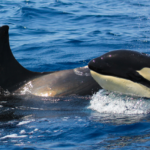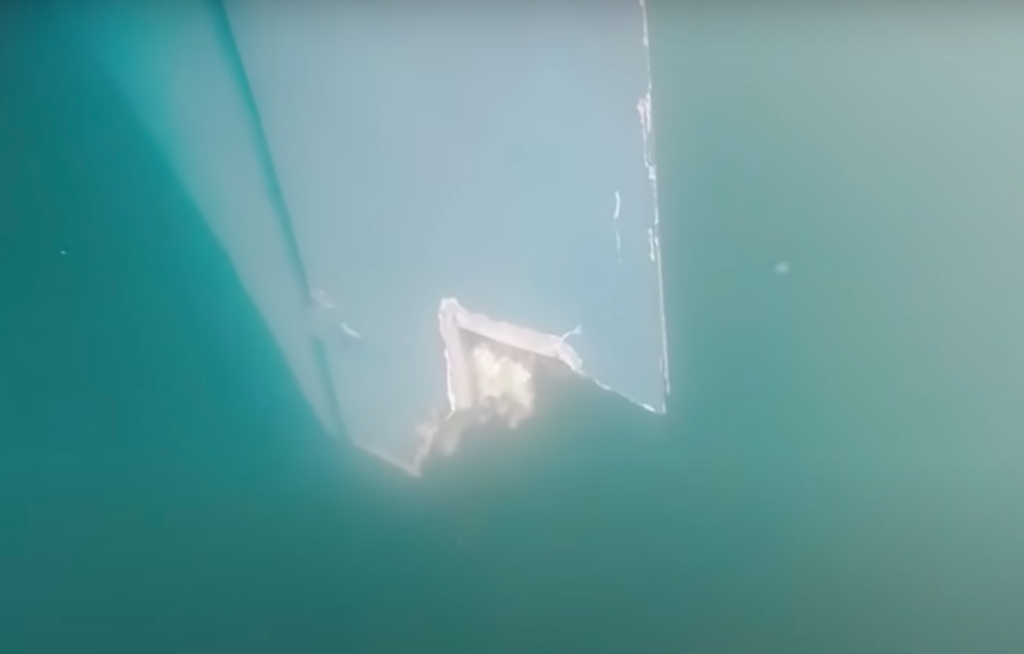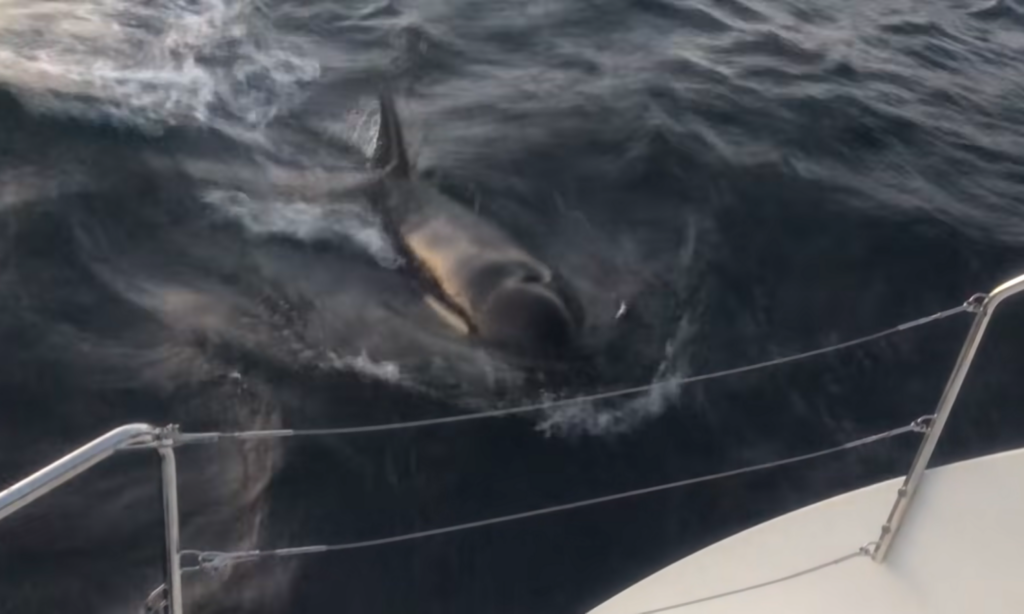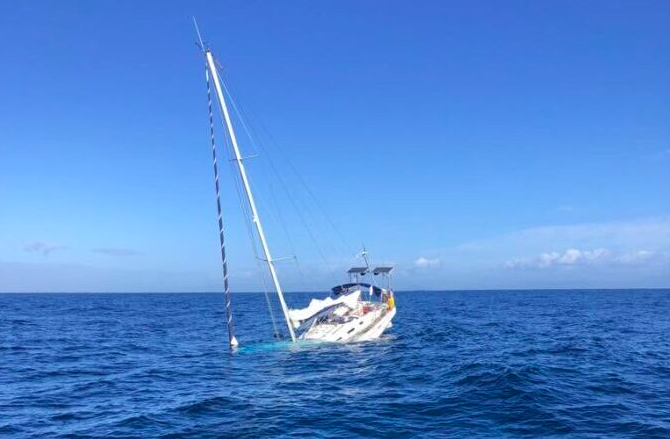
Black antifoul suspected cause of orca attacks

The last couple of years have proved perilous for some sailing the Iberian coastline. Once boats could amble at leisure, but since 2020 there have been over 100 orca ‘interactions’ where boats have been spun around and repeatedly rammed, two of which incidents have ended in yachts sinking.
According to the Cruising Association, 15 per cent of the boats involved in interactions end up being towed to shore. Thus the organisation has taken up the challenge of collating reports, to analyse data and then try to reduce risk for those in the Gibraltar Straits.
Initially three specific orca were identified as the culprits, but there are now 17 actively involved in pushing / spinning / ramming and biting rudders in interactions lasting from a few minutes to up to an hour at a time, according to John Burbeck who’s leading the Cruising Association’s orca taskforce. He’s pleased with the amount of information the team has gleaned so far, but wants to encourage sailors to report all journeys — whether they have interactions or not.
Black antifoul suspected of causing orca attacks
After around six months of collating data, the team at the CA are currently looking at the possibility that black antifoul might factor into the orca behaviour.
“There are a high percentage of boats that are attacked that have got black antifouling. A low percentage of boats with black antifouling are having trouble-free voyages.
“If, on trouble-free voyages, you’ve only got 25 per cent of boats with black antifouling, why on the attack side, have you got more than 50 per cent with black?” says Burbeck. The risk appears to be doubling.
He repeatedly stresses that black antifoul is a ‘possible’ concern, and until more data is collected, it can only remain that. He says the statical validity will be called by an advisory company which the CA has is working with, but that won’t happen until a tranche of work is undertaken with AIS data, to try and assess the number of yachts passing through who didn’t report their voyages. The parameters of that piece of work are under discussion.
Burbeck also notes that “in the early stages we thought that having the echo sounder on was a problem, so we told people to turn it off. But we’ve found it makes no difference at all.” Similarly he’s aware that the black antifoul might turn into a red herring. But in the meantime, the CA is keenly waiting for more hard data to become available. It’s asking sailors, marinas and rescue services to spread the word about completing the online orca report information in order to help understand the orca behaviour.

Sand may disable an orca attack
The data currently suggests the best way to reduce risk is to stay in shallow water, be less than two miles offshore, and travel quickly.
Burbeck says current advice for when a problem starts is to make a sudden loud noise, or reverse and/or pour sand over the orca.
“In some circumstances sand might dissuade them – we think because they can’t see properly and can’t see the rudder. And there’s not much else that we are certain of at the moment.
“But we know lots of things that don’t make a difference.
“Whether you have your echo sounder on doesn’t seem to make a difference. We thought towing a fishing line might be a possibility, but that doesn’t seem to make a difference either.”
Worst case scenario for orca attacking yachts
Burbeck is keen for as many sailors as possible to spread the word about completing voyage reports so more data can be analysed and risk can be reduced, especially before the worst-case scenario happens, which would be someone dying.
“If someone dies the risk to the orca will be significant. It will be problematic. There’s a growing body of people who view the orca as expendable.
“We know local yachts are using firecrackers — there is evidence — and we hear people saying orca are expendable.
“But we are entering their environment. It’s a bit like going into the jungle with lions and tigers — you know you’re taking a risk. You take precautions to keep you safe. People get killed and attacked periodically, but that might be the analogy for these waters. Proportionately there are quite a lot of yachts with a lot of people onboard, but every now and then one of them gets sunk.
“I believe that the local governments — particularly the Portuguese — will take a death seriously. We suspect that there is research going on about tagging and legal pingers and devices that would drive the orca off. We hear of this anecdotally, but at this stage we cannot confirm it.”
Burbeck says the best-case scenario would be if the orca suddenly stop, in the same way they suddenly started. He says there are historical reports of orca adopting behaviours for a finite amount of time. The second best case would be accessing enough data to enable sailors to get through safely. And, he notes, that circa 30 per cent of those who report interactions say the orca just came to investigate and then left again. And if neither of these are the case?
“Perhaps we have to rethink.
“We’ll need to travel in groups, have a guide, stay in shallow water, and travel even faster, rather than ambling through as we always have done, where the wind and sun takes you. I wouldn’t do that now.”
 Damaged rudder after orca interaction. Courtesy of Martin Evans via YouTube
Damaged rudder after orca interaction. Courtesy of Martin Evans via YouTubeReporting orca interactions, sightings and non-eventful passages
The Cruising Association’s reporting tool is voluntary and is being used to help understand what is happening and why. It was set up in early 2022, ostensibly because no one else from the yachting world was providing assistance to the group of voluntary biologists from GTOA, who were raising the alarm.
Nautilus Project has also recently launched a new marine science app, Orcinus, which asks sailors to record the presence of orca in real-time. The app shares this information with the entire community of Orcinus app users which means navigators can re-plan their routes accordingly.

A Lagoon 450 was approached by orca off the Portuguese Coast. Image courtesy of Halcyon Yachts/YouTube
Are orca playing or attacking yachts?
Orca learn from one another, adopting distinct behaviours which mark them as culturally different from other orca groups. And the Gibraltar Straits group — which biologists have been tracking for circa fifty years — is roughly fifty strong. Which, if the numbers learning rudder-baiting increase at the same rate as last year, could see even more perilous interactions through 2023.
Reports of interactions (which are all available to read online) vary immensely in the crew’s interpretation of events as to what might be ‘playfulness’.
“Some of the attacks come completely out of the blue. There’s a crash and the rudder’s broken. Other times it’s obvious that they’re playing with the boat, because they spin it round and push it, and are clearly having the time of their lives playing until eventually the rudder breaks off and they lose interest. Some boats have been pushed up to four knots. They’re clearly playing, and other times they come in like a bullet and smash it off. If they always did it one way, you could say ‘it’s because’. Sometimes it’s a single orca, and sometimes it’s up to six,” says Burbeck.
One interaction report states clearly that the behaviour was playful.
“We think it was playing type of behaviour, since they were first hiding underwater with no bubbles or movement under the boat. And a second time they let us see them swim far away, only to circle back underwater and wait again, ready to attack. It seemed like they wanted us to move the rudder or boat so they could keep playing,” says report Inter36.
Another interaction which lasted 30-60 minutes, left the crew ‘paralysed’ by fear, says report Inter39.
“We had no desire to see them, just to hear their breath when they attacked made us want to have a large calibre weapon to kill them.”
This latter behaviour mirrors the experience of four crew members who were rescued after their boat was attacked by orcas (1 November 22) 25 km off the coast of Viana do Castelo.
 Four crew members were rescued after an orca attack off Viana do Castelo in Portugal. Image courtesy of Maritime Search and Rescue, Viana do Castelo
Four crew members were rescued after an orca attack off Viana do Castelo in Portugal. Image courtesy of Maritime Search and Rescue, Viana do CasteloWhy are orca attacking yachts?
Groupo Trabajo Orca Atlantica (GTOA) says the group of orca based in the Gibraltar Straits feed on tuna that come out of the Mediterranean after spawning. These orca are normally around from April to November and follow tuna around the south Spanish coast, up the Portuguese coast, and into the Bay of Biscay — before disappearing for the winter.
The reasoning behind the orca actions is, says Burbeck, the subject matter of much dinner-party debate. But, according to Alfredo Lopez of CEMMA, one of the scientists of the GTOA group, the orca ‘routine’ is based on a power situation — the orca do it because they can.
“It [an interaction] has different curiosity, game, dexterity and hunting components. With those different components the orca organises a new behaviour, like a puzzle, combining different things. They know how the rudders work.
“The orcas can have three motivations when they approach the boat (competition for speed, curiosity and skill, for example) and when they stop the boat, we are reducing the motivations to two. That is the reason for stopping the ship. If we increase the speed, in addition to not reducing motivations, we are increasing a new one: increased activity, blood pressure, adrenaline and excitement. At this point, things can get dangerous.
“A euphoric orca after having beaten the ship in speed and stopped the ship with the broken rudder, will be drunk with victory, therefore increasing his feeling of power and consequently his danger.
“A bull browsing the grass in the field is less dangerous than running after us, right? Well, let it graze in the field, don’t make it run.
“The cognitive ability of orcas is very great. We are in contact with researcher Robert Anderson who studies the behaviour of killer whales in captivity and has been interested in our work. He asked if killer whales observe human behaviour, and their reaction to broken rudders. The answer is ‘yes’, the orcas observe what happens on the boat, what the people on board do and say. He told us that in captivity, killer whales hide behind a parapet to force humans to peak out and when they peak out they wet them, they have fun like this, learning from human reactions and provoking others. This is why the protocol advises that you keep a low profile on deck.”
 Orca pod. Courtesy of Nathan Jones via YouTube
Orca pod. Courtesy of Nathan Jones via YouTubeSceptical about the interactions? Watch these clips
The post Black antifoul suspected cause of orca attacks appeared first on Marine Industry News.
